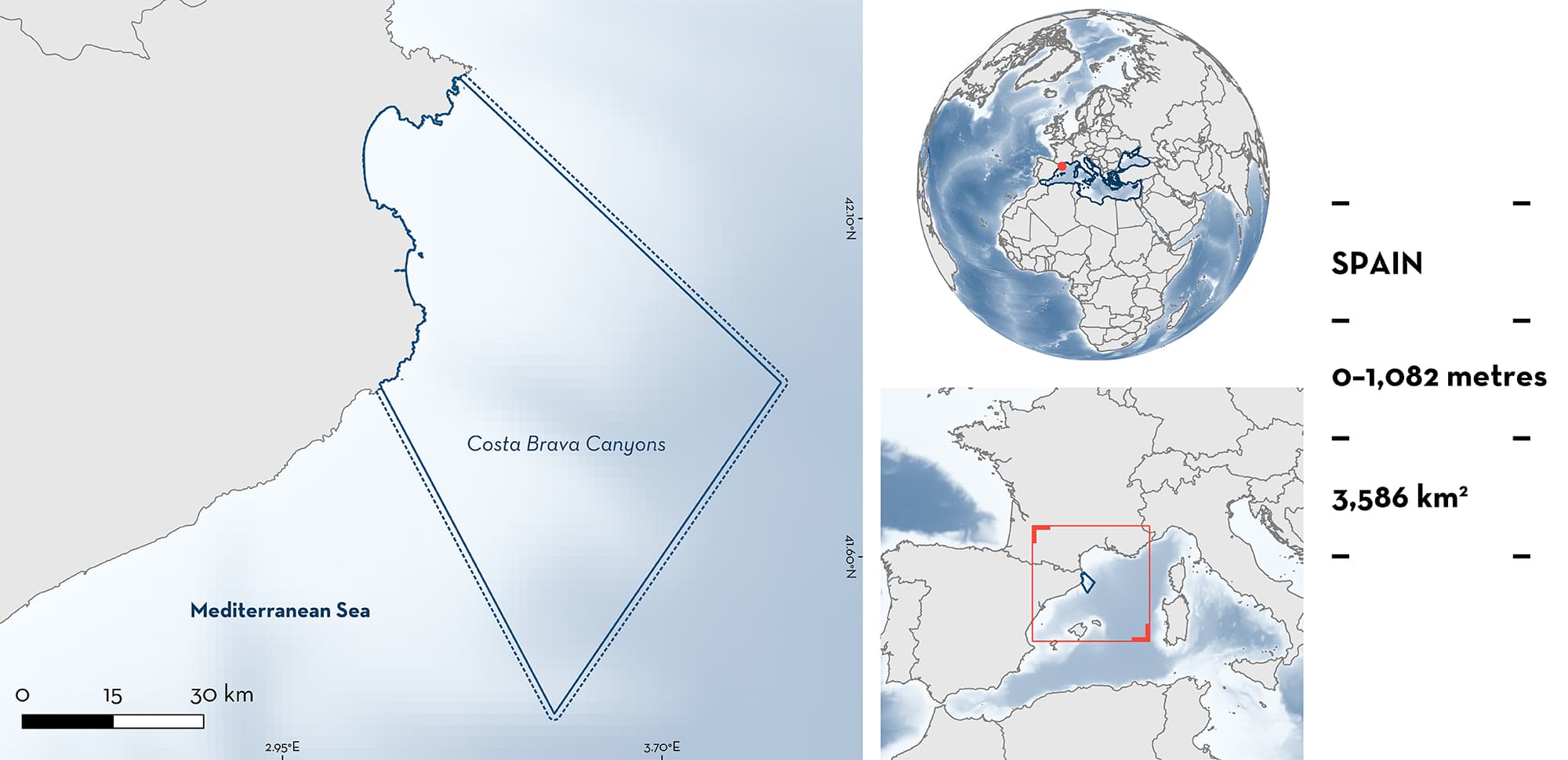ISRA FACTSHEETS
ISRA FACTSHEETS
MEDITERRANEAN AND BLACK SEAS REGION
Costa Brava Canyons
Summary
Costa Brava Canyons is located in the northwestern Mediterranean Sea, bordering the coast of northern Spain. The area has a narrow continental shelf carved by deepwater canyons. It is a high productivity area due to nutrient input from nearby rivers and coastal upwelling generated by winds blowing off the continent. In this area, the Northern Mediterranean Current flows southward along the continental slope. This area sits within the North-western Mediterranean Pelagic Ecosystems Ecologically or Biologically Significant Marine Area and partly overlaps with the Mar del Empordà Key Biodiversity Area. Within this area there are: threatened species and areas important for movement (Blue Shark Prionace glauca).
Download factsheet
Costa Brava Canyons
DESCRIPTION OF HABITAT
Costa Brava Canyons borders the coastline of north Catalonia in Spain. The continental shelf edge in this area is incised by a network of submarine canyons that converge at the base of the continental slope and reach depths >2,000 m. Due to differences in the width of the shelf along the continental margin, canyon heads can be relatively close to the coast (6–7 km from the coast; Demestre et al. 2000).
The Northern Mediterranean Current flows southward along the continental slope and carries waters with a high concentration of organic matter from the Gulf of Lion to the area (Poisson et al. submitted). Nearby rivers (mainly the Rhône and, locally, the Muga, Ter, and Fluvià rivers) also transport high concentrations of nutrients into the area which, coupled with wind-induced mixing and upwelling, lead to high primary productivity (Fundación Biodiversidad 2014). Upwelling events occur on canyon heads and are driven by northerly and north-westerly winds.
The area sits within the North-western Mediterranean Pelagic Ecosystems Ecologically or Biologically Significant Marine Area (CBD 2023) and partly overlaps with the Mar del Empordà Key Biodiversity Area (KBA 2023).
This Important Shark and Ray Area is pelagic and is delineated from surface waters (0 m) to 1,082 m based on the global depth range of the Qualifying Species and the bathymetry of the area.
CRITERION A
VULNERABILITY
The one Qualifying Species within the area is considered threatened with extinction according to the IUCN Red List of Threatened SpeciesTM. The Blue Shark is assessed as Near Threatened globally and Critically Endangered in the Mediterranean Sea (Sims et al. 2016).
CRITERION C
SUB-CRITERION C4 – MOVEMENT
Costa Brava Canyons is an important movement area for one species of shark.
From July 2012 to May 2017, 39 Blue Sharks were tagged in three areas of the Western Mediterranean Basin with contrasting oceanographic features: (1) Gulf of Lion, (2) Ligurian Sea, and (3) Northern Alboran Sea near the Strait of Gibraltar (Poisson et al. submitted). Individuals were tagged with different satellite transmitters: three types of fin-mounted satellite tags (n = 32) and two types of pop-up satellite archival transmitting (n = 8).
Animals across size-classes were tagged. The male : female sex ratio greatly favoured females (1 : 2.9) with 3 juvenile males (110–127 cm fork length [FL]), 6 juvenile females (119–130 cm FL), 3 large juvenile males (142–167 cm FL), 22 large juvenile females (131–178 cm FL), 4 adult males (185–295 cm FL), and 1 adult female (208 cm FL).
Individuals tagged in the Eastern Gulf of Lion or in the adjacent Ligurian Sea (n = 9 individuals; tagged between August 2014 and August 2016) moved through the Costa Brava Canyons before going southwards towards the Alboran Sea, following the Northern Mediterranean Current (Poisson et al. submitted; Stellaris Association 2023). Further, one shark tagged (out of 9) in distant Alboran Sea was also found within the area.
Download factsheet
SUBMIT A REQUEST
ISRA SPATIAL LAYER REQUEST
To make a request to download the ISRA Layer in either a GIS compatible Shapefile (.shp) or Google Earth compatible Keyhole Markup Language Zipped file (.kmz) please complete the following form. We will review your request and send the download details to you. We will endeavor to send you the requested files as soon as we can. However, please note that this is not an automated process, and before requests are responded to, they undergo internal review and authorization. As such, requests normally take 5–10 working days to process.
Should you have questions about the data or process, please do not hesitate to contact us.


